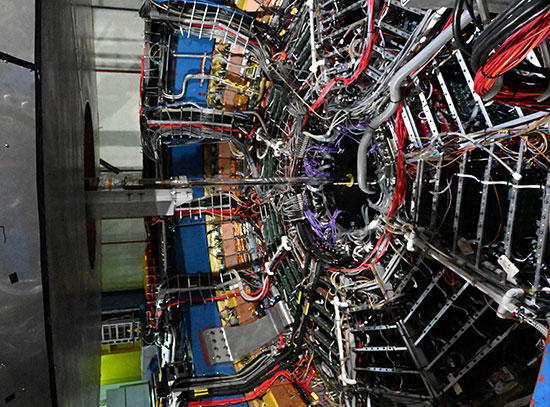Destination: Mars. First Stop: Iceland?
As researchers await the return of minerals from Mars, they study an analog much closer to home
November 17, 2025
 enlarge
enlarge
This picturesque vista is the watershed in southwest Iceland, where researchers collected mars rock analog samples. (Michael Thorpe/NASA Goddard)
UPTON, N.Y. — To say that a trip from Earth to Mars is merely a long one would be a massive understatement. On July 30, 2020, when the National Aeronautics and Space Administration (NASA) sent its Mars rover “Perseverance” atop an Atlas V rocket to the red planet to collect rock samples, it took the rover nearly seven months to reach its destination. This was only one step in a complex process that will take at least a decade to bring home these samples from Mars. While this is an unusually long wait for a sample shipment, it gives scientists ample time to find the best approach to study these rare and precious rocks.
In preparation, an international collaboration of scientists has started investigating sedimentary rock samples found in Iceland, a country whose terrain shares some compositional similarities and whose climate may be similar to ancient climates in certain Martian regions. Their results, published today in American Mineralogist, shed light on how high-resolution analyses of these complex, natural minerals can give scientists a deeper understanding of their geological history, both at home on Earth and 194 million miles away on Mars, though this requires careful interpretation. This collaboration is made up of researchers from the University of Maryland, NASA Goddard, Johnson Space Center, University of Göttingen, Chungbuk National University, and the National Synchrotron Light Source II (NSLS-II), a U.S. Department of Energy (DOE) Office of Science user facility at DOE’s Brookhaven National Laboratory.
Rocks from the land of fire and ice
Regions in Iceland have become popular analogs for Mars in recent years as similarities between them continue to emerge. The chief rock type in these areas, a volcanic rock called basalt, has been found in Martian meteorites and by the Curiosity and Perseverance rovers on the surface of the planet. Evidence of water and ice deposits on Mars suggests that there may have once been glaciers, lakes, and rivers. There are even volcanic features on each planet that bear a resemblance to each other.
“It's an amazing opportunity,” remarked Michael Thorpe, a research scientist at the University of Maryland and NASA’s Goddard Space Flight Center who led the study. “On Mars, we are exploring minerals that preserve a signature of ancient water but have also been buried and compressed into a rock over time. On the flip side, on Earth in Iceland, we are uncovering very young sediments that have similar minerals but haven’t gone through that rock-forming process yet. This speaks to geological time. What happened on Mars to allow these, what we would call “juvenile,” mineral phases to last in the sedimentary rock record? Did it happen when the planet lost its water? Was it just because it was really cold like Iceland? Or are there other factors at play here? There are mysteries locked within those Mars rocks that will make their way to Earth one day that our team is excited to try to unravel.”
The rocks Thorpe and the team were after are known as mudrocks, a type of sedimentary rock that consists of clay-like particles that are very common both on Earth and among what has been found so far on other rocky bodies in our solar system, like Mars. These particular samples were formed by glacio-fluvial sediments — sedimentary materials like sand, gravel, and clay that result from the combined action of glaciers and rivers. As glaciers move and erode large rocks, they pick up tiny pieces of them. Then, when the glacier melts or recedes, the extracted sediments are deposited into nearby river systems. Researchers took samples from a watershed in southwest Iceland where these systems meet. Despite their prevalence, analyzing these fine-grained sediments is challenging. Due to their small size and intricate makeup, high-resolution analyses are necessary for accurate interpretation.
“As we're preparing for these precious samples to make their journey from Mars, it’s becoming clear that we need to find cutting-edge techniques to give us a better understanding of what to expect when they arrive in our labs on Earth,” said Thorpe. “That's why the collaboration with NSLS-II has been so monumental and why I hope to continue building it.”
By getting a better understanding of the sedimentary processes that created these rocks, scientists can get a clearer picture of a planet's geological history. Previous studies that investigated samples from the same location were not able to fully characterize sediment with a grain size below four micrometers. Geologists often refer to these tiny particles as “clay-sized.” This study aimed to uncover these hidden characteristics using high-resolution techniques like transmission electron microscopy (TEM), powder X-ray diffraction (XRD), X-ray pair distribution function measurements, and X-ray fluorescence microscopy analysis.
 enlarge
enlarge
This illustration (a) maps the sediment's journey from source to sink. The accompanying conceptual model (b) demonstrates how amorphous materials are formed throughout the sedimentary system. (Michael Thorpe)
Common materials with complex stories
At the microscopic level, rocks and minerals have a variety of structures. The atoms and molecules that make up crystalline materials are stacked in a very specific order resulting in identifiable geometric shapes. In contrast, there are other phases in nature, dubbed amorphous materials, that lack this organized, long-range atomic ordering. Rocks comprised of several different sediments can pose a significant challenge for scientists who are trying to characterize them. Many clay minerals can have a structure that is difficult to analyze without high-resolution techniques. This is where the Pair Distribution Function (PDF) beamline at NSLS-II comes in.
“When we started this collaboration, we didn't realize how complex this analysis was going to be,” remarked Eric Dooryhee, program manager for NSLS-II’s Hard X-ray Scattering & Spectroscopy program. “These samples are mixtures of highly crystalline materials, other rocks and minerals that are more highly disordered, and even some materials that are amorphous. The mixture of signals coming from these differently structured materials is difficult to analyze in a qualitative way, such as by measuring the fractions of each mineral the sample is composed of and determining just how disordered or crystalline they are. These techniques are something we are still trying to perfect, which is why I like this kind of research.”
 enlarge
enlarge
In synchrotron patterns (brown, red, blue), clay minerals have broad and subtle peaks, identified in the upper left as "clay 001" for a smectite clay, "K/S" for a kaolinite and smectite clay mixture, and "kaolinite 001". Importantly, these peaks are not seen in the traditional patterns (grey) obtained by laboratory instrumentation. (Brookhaven National Laboratory)
The challenge of characterizing sediments of this size and structure has always been a hurdle for minerologists. Studies like this help to improve current X-ray techniques and pave the way for new tools to further analyze these types of materials, both here on Earth and beyond.
To complement these structural measurements, the team looked at the chemistry and elemental composition of the sediments using the Submicron Resolution X-ray Spectroscopy (SRX) beamline at NSLS-II. The researchers took samples from different types of terrain within the area and measured the concentration of specific elements in each sample.
“We found that each tiny grain of sediment wasn’t comprised of just one element or even just one kind of material,” explained Juergen Thieme, Stony Brook University adjunct professor and former SRX beamline scientist. “We were able to capture the microheterogeneity of these tiny samples, the variation of their chemical structure, right down to trace elements.”
Iron and calcium were abundant in all of the samples, but the distribution of these elements seemed dependent on the terrain they were found in. Imaging at SRX also helped the team determine the oxidation state of iron in the sediment, which may be the effects of weathering. Deciphering these clues about the sediment’s journey could help researchers picture what Mars may have looked like before it turned into the inhospitable planet it is now.
“The complexity of these studies is really fun on the terrestrial side of things,” said Thorpe. “Each of those different phases, although they're hard to quantify, tells us a different part of the story in terms of weathering, climate, and all the other complex processes that happened in this sediment’s journey from the mountains to the ocean. When we get these complex, natural samples back from Mars, too, which we know will have a bunch of similar minerals and amorphous materials in them, will we be ready to identify what those phases are? We’re hoping these samples from Iceland and other analogs on Earth will guide us in answering that.”
Through a high-resolution analysis, the team got a more detailed understanding of how these sediments came together over time. They were surprised at just how much each sample appeared to change in response to the environments that they were exposed to during their journey. These rocks weren’t a simple story told in easily interpreted layers; they had complex twists, turns, and developments. They gained and lost material, underwent structural changes, and adapted to factors like temperature, weather conditions, and even carbon dioxide levels. Scientists may have underestimated the number of changes that occurred over time and throughout the sedimentary process without these hidden microscopic hints. As scientists become able to characterize these samples from the inside out with high-resolution X-ray techniques and advanced microscopy to refine their interpretations, they gain a more complete picture of the conditions that shape these tiny time capsules in each unique ecosystem. Learning the language of these rocks through their stories is essential to understanding the stories of planets that no longer have the features to tell them.
 enlarge
enlarge
These SRX elemental maps use a color ramp to display relative intensity within each sample site analysis, with red indicating more intense elemental concentrations and blue indicating where concentrations are less abundant. (Michael Thorpe)
Playing the waiting game
Though there are still challenges to overcome in translating the stories of sedimentary rocks here on Earth, researchers are eager to see how these processes translate on Mars. NASA’s Mars Sample Return Campaign aims to bring these extraterrestrial rocks to Earth in the most efficient way, but that process will take several years. NASA is calling on the community to put forth their best ideas to expedite this process.
Considering how difficult it is to collect and return these precious samples, scientists will exercise extreme caution when studying them. The rocks will be safely contained in a sealed metal tube that can’t be opened and exposed to damage or alteration from earth’s atmosphere. High-energy X-rays will be necessary to penetrate the metal container and analyze its contents. In the meantime, Thorpe is looking towards other frontiers that are closer to home.
“I am always pushing myself for more answers, and even if I end up proving myself wrong, that’s part of the scientific mindset,” he said. “Iceland has always been a great analog, but I want to know if there are other pieces to the sedimentary puzzle that are missing. To continue that journey, our team went to Lanzarote, Spain, which is formed from the same kind of rocks. It’s a warmer climate with torrential rain, which may introduce a higher degree of weathering. Perhaps this climate can provide new features to a dynamic story in volcanic terrains. I always plan to keep asking questions, searching in new places, and pushing our collaborations and technical approaches to the next level.”
Brookhaven National Laboratory is supported by the Office of Science of the U.S. Department of Energy. The Office of Science is the single largest supporter of basic research in the physical sciences in the United States and is working to address some of the most pressing challenges of our time. For more information, visit science.energy.gov.
Follow @BrookhavenLab on social media. Find us on Instagram, LinkedIn, X, and Facebook.
2025-21644 | INT/EXT | Newsroom









